Sights and Activities
Below are the places we saw and activities completed while visiting China:
Huangshan Mountains
We started our journey to these magnificent towering mountains by taking a cable car up to the summit. The area is full of paved trails that meander through several different peaks. The views of the enormous granite rock formations and the sea of clouds are staggering. The Chinese have given many of the peaks fancy and philosophical names, these are some of the peaks we viewed: Beginning to Believe Peak, Purple Cloud Peak, and Nine Dragons Peak. We spent two nights at the summit and were fortunate to be mesmerized by the beautiful colors the sunset made behind the peaks. The early morning sunrise was not as impressive due to the high clouds, but we then visited the West Sea Canyon on our hike through Ring Road 1 and 2 that even more dramatic sights. The trails in this area turn into stone steps attached to the side of the mountains that peer over the side with teeth grinding views straight down! We ended our visit by taking the cable car back down.
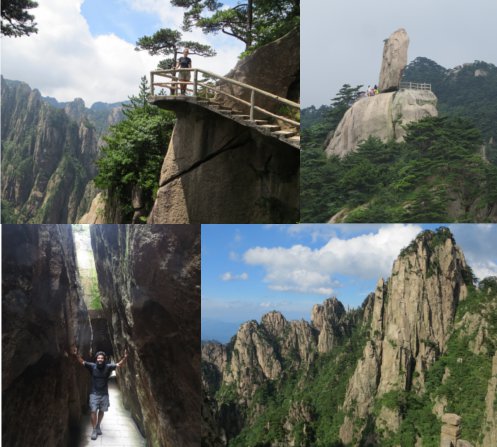
Hongcun
A bridge over a picturesque lake leads to the entrance of this village that attracts many local art students to create paintings of the ancient architecture and landscapes. We spent two days and one night exploring the many notable buildings that included the Chengzhi Hall, South Lake Academy, and the Hall of the Peach Garden. The highlight of this Unesco World Heritage site is the crescent-shaped Moon Pond located at the heart of the city and spectacularly reflects the surrounding traditional houses, especially at night.

Shanghai
People’s Square and People’s Park: at the heart of this modern city, the square and park are surrounded with museums and performing art venues.
Urban Planning Exhibition Hall: this unique museum displayed future plans of the city with an incredible model layout and a wrap-around 3-D tour.
Tianzifang: spent an evening walking around this entertainment complex with traditional longtangs (alleyways), but the small cafes and boutiques make it a French colony.

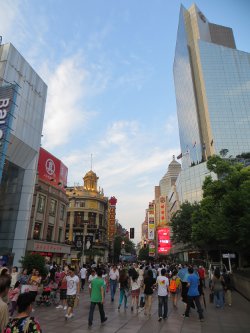
East Nanjing Road: this outdoor shopping mall with its Western feel is one of the most famous and crowded streets in China. This is where the first department stores in China were opened in the 1920s.
The Bund: we strolled through this boardwalk with great views of the skyline on one side and antique buildings that house designer retail stores and restaurants on the other.
Shanghai History Museum: this museum displayed the history of Shanghai. The exhibits included models of traditional shops during the city’s trading days and details on the international settlement.
Beijing
Tian’anmen Square: the world’s largest public square located at the heart of Beijing. The “public square” remains more in the hands of the government than the people; it is monitored by cameras and many police. We had to go through security every time we entered.
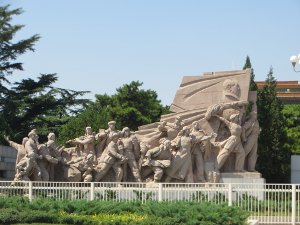
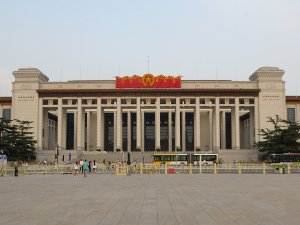
China National Museum: we viewed a couple of exhibits in this newly remodeled building: Ancient China and Architectural Design of the Museum.
Beijing Planning Exhibition Hall: this museum did not match the sophistication of Shanghai’s, but the detailed city model was impressive.
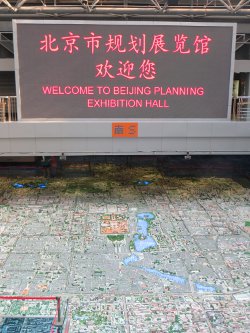
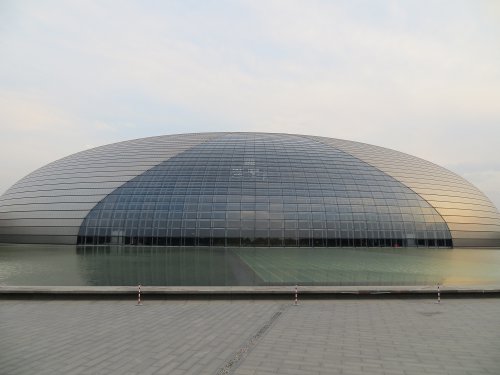
National Center for Performing Arts Building: we walked by and viewed this modern glass structure from the exterior.
Bell Tower: we climbed up this tower that dates back to the 18th century. Although the city views were smoggy, there were great views of the hutong roofs and alleyways, traditional Chinese neighborhoods.
Drum Tower: we climbed up this tower to enjoy a drum ceremony and views of the smoggy city.
Drum Tower Ceremony
Nanluogu Xiang Historic Street: we joined the masses of people in this touristy hutong with everything from western stores and restaurants to traditional rock carving and crowds of Chinese photographing everything.
Temple of Heaven Park: this large park featured many Confucian designed colorful temples. This is one of China’s busiest urban landscapes that is surrounded by perimeter walls with a gate at each compass point.
Gate of Heavenly Peace: before entering the Forbidden City, we walked through this national symbol. Built in the 15th century and restored in the 17th century, its purpose was to protect and envelope the imperial grounds, but when Mao Zedong proclaimed the People’s Republic in 1949 his gigantic portrait became the dominating feature.

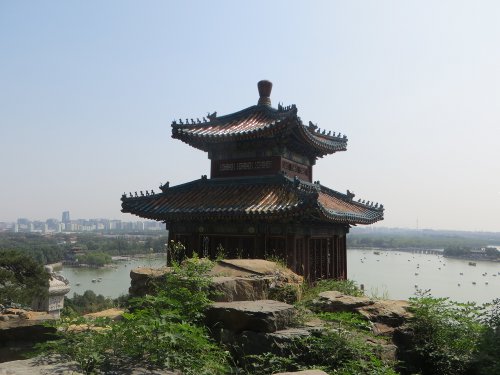
Forbidden City (Palace Museum): known as the Forbidden City because it was off limits to the common people for over 500 years. We took an audio tour of China’s largest and best preserved complex of ancient buildings to learn about the two dynasties that called it home. We spent half a day hearing about the emperors, empresses, and concubines.
Olympic Park: we saw the Aquatic Center and the National Stadium (Bird’s Nest) that were a hit in the Beijing Olympics, but unfortunately the day was really cloudy and were not able to get great pictures.
Summer Palace: these grounds with its palace, temples, gardens, pavilions, lakes, and bridges were once a playground for the imperial court. We enjoyed the hilly, park-like feel of the complex for half-a-day while viewing great lake and temple scenery.
Xi’an
Great Mosque: one of the largest mosques in China, this mosque was a unique blend of Chinese and Islamic architecture. Founded in the 8th century, the mosque features Chinese gardens and Arab minarets.
Muslim Quarters: we walked through the streets of this Muslim community full of street vendors with tasty snacks alongside men in white skullcaps and women with their heads covered in colored scarves.
Drum Tower and Bell Tower: both towers date back from the 14th century and were rebuilt in the 1700’s. The Bell Tower sits in the middle of Xian and shines brightly at night while the Drum Tower is not as visible.
Emperor Qin Shi Huang’s Mausoleum Site Museum (Terracotta Warriors): one of the most famous archaeological finds in the world and, in our opinion, an artistic masterpiece with so many artists involved and no two soldier’s face being alike. It is unbelievable to think this was all done not only for one person, but for his tomb, when he is dead! It is believed that either Qin Shi Huang was terrified of the vanquished spirits awaiting him in the afterlife, or, as most archaeologists believe, he expected his rule to continue in death as it had in life. The discovery of the army was made in 1974 by peasants drilling a well which uncovered an underground vault that eventually led to thousands of terracotta soldiers and horses in battle formation. In a way, the emperor’s wishes were granted, with thousands of visitors flocking to see this subterranean life-size Terracotta Army.
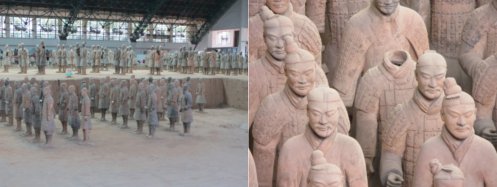
City Walls: we climbed up on top of these ancient walls and walked from the West gate to the South gate. Most sections of this 12-meter high wall, which was originally built in 1370, have been restored or rebuilt and provide views of the city.
Big Goose Pagoda: built in 652 AD to house the Buddhist sutras brought back from India by the monk Xuan Zang.

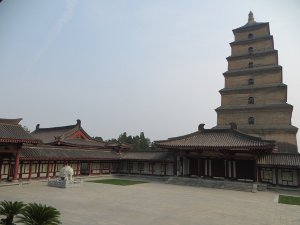
Pingyao
Pingyao is one of China’s ancient walled towns. The touristy village did not match the charm of Hongcun, but still had interesting ancient architecture, red-lantern-hung lanes, towers poking into the sky, and lots of temples. The featured sites include: the City Walls that date back to 1370 and has been mostly kept all original; the City Tower that towers in the middle of the town; and the Confucian Temple which houses Pingyao’s oldest surviving building, Dacheng Hall.
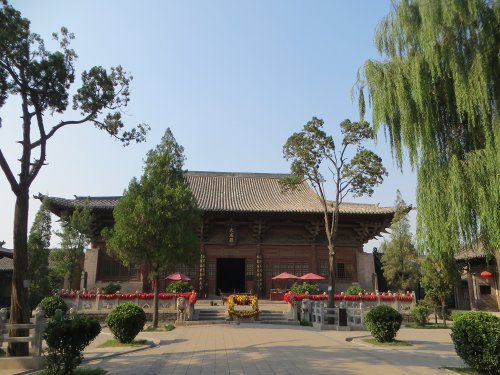
Xizhazi Village
We headed to this country side village in search of some adventure, to have the Great Wall of China all to ourselves. This portion of the Great Wall, known as Jiankou, with its gorgeous hikes is seldom visited by tourists. Little did we know the two nights we spent in this area were going to be one of the highlights of our visit to China. Please be sure to read our article to learn about our adventure.
